It was the fifteenth time I’d trekked to Columbus, Georgia, to the gate of Fort Benning, for the annual November demonstration to close the School of the Americas.
Since 1989, following the murder of six Jesuit priests in San Salvador by graduates of the SOA, the effort to close it down has been led by Mary Knoll priest Father Roy Bourgeois, a Vietnam veteran and a priest who served in Bolivia during a very violent period hostile to priests sympathetic to the plight of the poor. The school is used to train foreign soldiers.
Bourgeois is a legend for a famous and clever act of civil disobedience. Dressed as an Army colonel, he went on post, climbed a tree and chained himself and a large boom box to the tree outside the barracks where Salvadoran soldiers were sleeping.
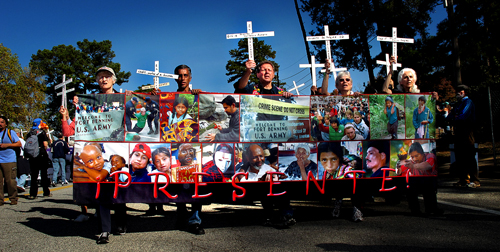 Father Roy Bourgeois, center, leads the procession to the gate of Fort Benning (Photos: John Grant)
Father Roy Bourgeois, center, leads the procession to the gate of Fort Benning (Photos: John Grant)
Bourgeois blasted a tape of Archbishop Oscar Romero’s famous speech (excerpted in the photo above) to the Salvadoran peasant-class soldiers: “I beg you, I ask you, I order you, in the name of God, to stop the repression.” It was after this 1980 speech that he was gunned down giving mass in a chapel.
Bourgeois spent four years in prison for that effort.
The scales fell from my eyes concerning the plight of the poor in places like El Salvador thanks to a number of incredible trips as a photographer there and to other Central American nations. I met the sole survivor of the El Mozote massacre, which had been undertaken by grads of the SOA. Involvement with the Close The SOA effort was a natural and I’ve been there every November since the mid-1990s.
Back in the early days, the police presence was quite nasty, but over the years it became pretty routine and the police became calmer and sometimes even friendly. The local merchants and restaurants loved the demonstration, since it meant extra millions of dollars each year in revenue.
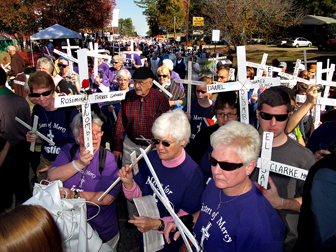 Demonstrators process toward the gate: "Presente!"
Demonstrators process toward the gate: "Presente!"
At the height of the demonstration in the years just before and just after 2000, the numbers reached 17,000 and 20,000. It was so successful the Army responded, as it often does to criticism and questions, with a public relations move: It re-named the school the Western Hemisphere Institute For Security Cooperation or WHINSEC — as if that would make the school’s bloody history evaporate into thin air.
The number of demonstrators has been dropping over the past two years. This year, it was down in the 7,000 range. Still, the enthusiasm and moral outrage of those attending was palpable. And still, the annual procession of the reading of the names of the dead from SOA alum killings – each followed by a robust collective “Presente!” – was as moving as ever.
The New York Times finally shows up
On Monday following the Sunday procession, The New York Times did a major story with a huge photo with the headline “The Protest Dwindles, If Not It’s Passion.” That did sorta get it right. But their shame lies in never having given the demonstration more than a tiny blink of coverage when it was huge and kickin’ ass.
Numbers were down for a host of speculative reasons, from the economy to internal issues within the Catholic hierarchy, especially with the Jesuits who this year did not encourage their flock as they have done in the past. In August 2008, the Roman Catholic Church excommunicated Bourgeois for participating in a female priest ordination ceremony. Some funding was lost.
As always, the weekend — Friday, November 19 to Sunday, November 21 — was full of events in solidarity with the victims of those trained at the SOA in a host of infamous massacres and atrocities in Latin American history. The events culminated in the solemn Sunday procession, which ended with everyone placing their small named white crosses and other items into the chain link fence spread across the gate.
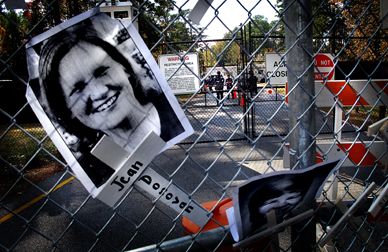 The fence with a photo of murdered religious worker Jean Donovan
The fence with a photo of murdered religious worker Jean Donovan
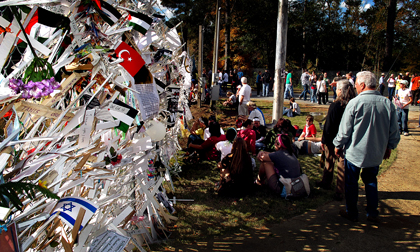 The fence at gate at the end of the procession
The fence at gate at the end of the procession
As the procession came to a close, as always, the fence was jammed with crosses, photographs and assorted mementos, a sight that sends a powerful symbolic message contrary to the US tradition of using military violence to secure US control around the world. At the end of the day, it’s all ripped down and taken away by city trash trucks.
Twenty-four people were arrested on Saturday and charged with unlawful assembly, failure to disperse and parading without a permit. Those arrested included four journalists, who were reportedly treated rather roughly. The issue was crossing barriers, which I can attest can be quite confusing – and of course annoying. Bail was set unusually high at $5000.
There had clearly been a decision made on a high level to beef up the police presence, which naturally increases the tension and seems to instill in the minds of bored police officers the delusion they aren’t facing non-violent citizens legally redressing their government, but instead, dangerous “terrorists” that must be insulted and rigidly controlled lest they run amok and terrorize the town.
On Sunday, four individuals climbed over the barbed wire-topped fence at the gate and were arrested inside the base. They will likely receive a six month prison sentence.
A Great Day For Overtime
When I arrived on Saturday afternoon at the gate area my friends and I ran into around ten squad cars with blue lights flashing. We were barred from proceeding to the gate, something that had never happened as far back as I can recall. A greater restriction of movement was noticeable.
We queried the young officer barring our progress. But of course he knew nothing about why he was stopping us. He was doing what he was told. We asked him about the duty and he said he was delighted to be working and making good overtime pay. A survey of patches suggested cops had been brought in from all over the region.
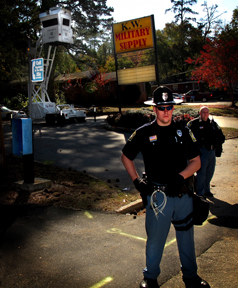 A local police officer guards Fort Benning from peaceful demonstrators
A local police officer guards Fort Benning from peaceful demonstrators
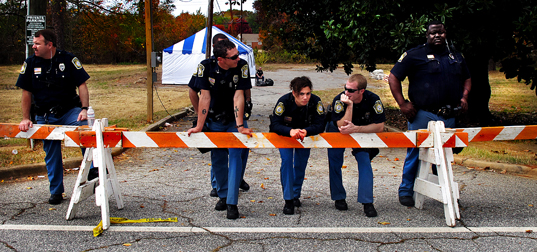 Police officers earning their overtime pay
Police officers earning their overtime pay
One of the most obnoxious aspects of the procession is a periodic taped loudspeaker announcement from within the base. The man’s voice proclaims how the US Military must preserve its detachment from politics and that there are proper avenues for redress of political grievances in the democracy the US Military is Constitutionally mandated to protect.
Knowing that SOA graduates have so willingly used violence and tactics taught at the school to influence local politics and knowing the tremendous power the US Military Industrial Complex has over all of our political lives and knowing how the US Military Budget is up to its neck in “politics as usual” – it always makes the periodically repeated taped speech an especially offensive mockery.
The subtext message broadcast from within the base to the assembled citizens opposing runaway defense budgets and state-sponsored violence and terrorism is clear and strong:
As an institution, we have the weapons, the prisons, The New York Times, the local police, the Congress and the President of the United States in our pockets. You demonstrators should feel lucky we let you live.
